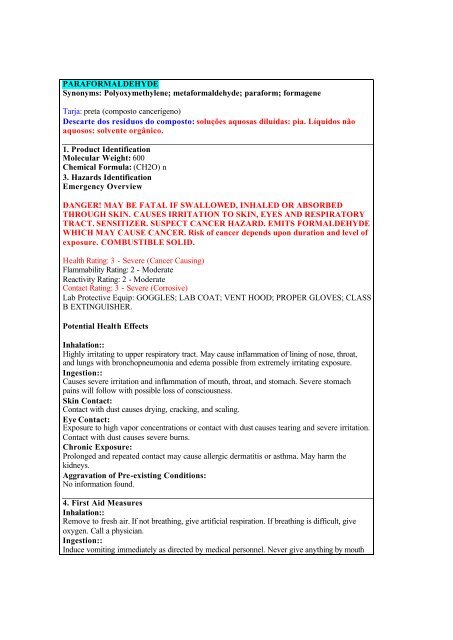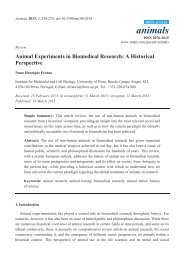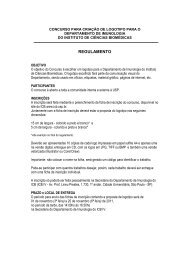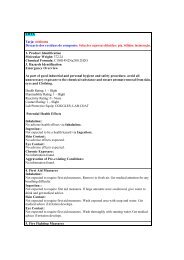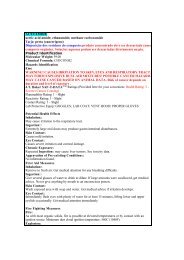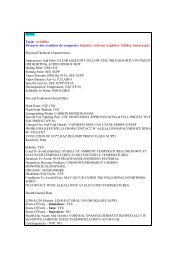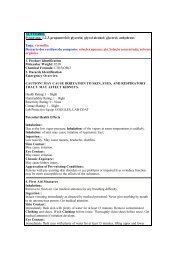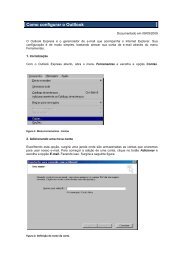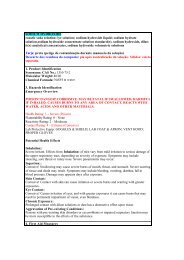PARAFORMALDEHYDE Synonyms: Polyoxymethylene ... - USP
PARAFORMALDEHYDE Synonyms: Polyoxymethylene ... - USP
PARAFORMALDEHYDE Synonyms: Polyoxymethylene ... - USP
You also want an ePaper? Increase the reach of your titles
YUMPU automatically turns print PDFs into web optimized ePapers that Google loves.
<strong>PARAFORMALDEHYDE</strong><br />
<strong>Synonyms</strong>: <strong>Polyoxymethylene</strong>; metaformaldehyde; paraform; formagene<br />
Tarja: preta (composto cancerígeno)<br />
Descarte dos resíduos do composto: soluções aquosas diluídas: pia. Líquidos não<br />
aquosos: solvente orgânico.<br />
1. Product Identification<br />
Molecular Weight: 600<br />
Chemical Formula: (CH2O) n<br />
3. Hazards Identification<br />
Emergency Overview<br />
DANGER! MAY BE FATAL IF SWALLOWED, INHALED OR ABSORBED<br />
THROUGH SKIN. CAUSES IRRITATION TO SKIN, EYES AND RESPIRATORY<br />
TRACT. SENSITIZER. S<strong>USP</strong>ECT CANCER HAZARD. EMITS FORMALDEHYDE<br />
WHICH MAY CAUSE CANCER. Risk of cancer depends upon duration and level of<br />
exposure. COMBUSTIBLE SOLID.<br />
Health Rating: 3 - Severe (Cancer Causing)<br />
Flammability Rating: 2 - Moderate<br />
Reactivity Rating: 2 - Moderate<br />
Contact Rating: 3 - Severe (Corrosive)<br />
Lab Protective Equip: GOGGLES; LAB COAT; VENT HOOD; PROPER GLOVES; CLASS<br />
B EXTINGUISHER.<br />
Potential Health Effects<br />
Inhalation::<br />
Highly irritating to upper respiratory tract. May cause inflammation of lining of nose, throat,<br />
and lungs with bronchopneumonia and edema possible from extremely irritating exposure.<br />
Ingestion::<br />
Causes severe irritation and inflammation of mouth, throat, and stomach. Severe stomach<br />
pains will follow with possible loss of consciousness.<br />
Skin Contact:<br />
Contact with dust causes drying, cracking, and scaling.<br />
Eye Contact:<br />
Exposure to high vapor concentrations or contact with dust causes tearing and severe irritation.<br />
Contact with dust causes severe burns.<br />
Chronic Exposure:<br />
Prolonged and repeated contact may cause allergic dermatitis or asthma. May harm the<br />
kidneys.<br />
Aggravation of Pre-existing Conditions:<br />
No information found.<br />
4. First Aid Measures<br />
Inhalation::<br />
Remove to fresh air. If not breathing, give artificial respiration. If breathing is difficult, give<br />
oxygen. Call a physician.<br />
Ingestion::<br />
Induce vomiting immediately as directed by medical personnel. Never give anything by mouth
to an unconscious person.<br />
Skin Contact:<br />
In case of contact, immediately flush skin with plenty of water for at least 15 minutes while<br />
removing contaminated Clothing and shoes. Wash Clothing before reuse. Thoroughly clean<br />
shoes before reuse. Get medical attention immediately.<br />
Eye Contact:<br />
Immediately flush eyes with plenty of water for at least 15 minutes, lifting lower and upper<br />
eyelids occasionally. Get medical attention immediately.<br />
5. Fire Fighting Measures<br />
Fire:<br />
Flash point: 70C (158F) CC<br />
Autoignition temperature: 300C (572F)<br />
Flammable limits in air % by volume:<br />
lel: 7.0; uel: 73<br />
Combustible solid.<br />
Explosion:<br />
Above flash point, vapor-air mixtures are explosive within flammable limits noted above. Fine<br />
dust dispersed in air in sufficient concentrations, and in the presence of an ignition source is a<br />
potential dust explosion hazard.<br />
Fire Extinguishing Media:<br />
Water spray, dry chemical, alcohol foam, or carbon dioxide. Water spray may be used to keep<br />
fire exposed containers cool.<br />
Special Information:<br />
In the event of a fire, wear full protective Clothing and NIOSH-approved self-contained<br />
breathing apparatus with full facepiece operated in the pressure demand or other positive<br />
pressure mode.<br />
6. Accidental Release Measures<br />
Remove all sources of ignition. Ventilate area of leak or spill. Wear appropriate personal<br />
protective equipment as specified in Section 8. Spills: Clean up spills in a manner that does not<br />
disperse dust into the air. Use non-sparking tools and equipment. Reduce airborne dust and<br />
prevent scattering by moistening with water. Pick up spill for recovery or disposal and place in<br />
a closed container. US Regulations (CERCLA) require reporting spills and releases to soil,<br />
water and air in excess of reportable quantities. The toll free number for the US Coast Guard<br />
National Response Center is (800) 424-8802.<br />
7. Handling: and Storage<br />
Store in a tightly closed container. Protect against physical damage. Outside or detached<br />
Storage is preferred. Inside Storage should be in a standard flammable liquids Storage room<br />
or cabinet. Separate from oxidizing materials. Storage and use areas should be No Smoking<br />
areas. Wear special protective equipment (Sec. 8) for maintenance break-in or where<br />
exposures may exceed established exposure levels. Wash hands, face, forearms and neck when<br />
exiting restricted areas. Shower, dispose of outer Clothing, change to clean garments at the<br />
end of the day. Avoid cross-contamination of street clothes. Wash hands before eating and do<br />
not eat, drink, or smoke in workplace. Avoid dust formation and control ignition sources.<br />
Employ grounding, venting and explosion relief provisions in accord with accepted<br />
engineering practices in any process capable of generating dust and/or static electricity. Empty<br />
only into inert or non-flammable atmosphere. Emptying contents into a non-inert atmosphere<br />
where flammable vapors may be present could cause a flash fire or explosion due to<br />
electrostatic discharge. Containers of this material may be hazardous when empty since they
etain product residues (dust, solids); observe all warnings and precautions listed for the<br />
product.<br />
8. Exposure Controls/Personal Protection<br />
Airborne Exposure Limits:<br />
Toxic formaldehyde gas may be produced if paraformaldehyde decomposes.<br />
For Formaldehyde:<br />
- OSHA Permissible Exposure Limit (PEL) -<br />
0.5 ppm (Action Level), 0.75 ppm (TWA), 2 ppm (STEL), Cancer-Suspect Agent.<br />
- ACGIH Threshold Limit Value (TLV) -<br />
0.3 ppm (STEL/Ceiling), A2 - Suspected human carcinogen.<br />
Ventilation System:<br />
A system of local and/or general exhaust is recommended to keep employee exposures below<br />
the Airborne Exposure Limits. Local exhaust ventilation is generally preferred because it can<br />
control the emissions of the contaminant at its source, preventing dispersion of it into the<br />
general work area. Please refer to the ACGIH document, Industrial Ventilation, A Manual of<br />
Recommended Practices, most recent edition, for details.<br />
Personal Respirators (NIOSH Approved):<br />
If the exposure limit is exceeded, a full facepiece respirator with a formaldehyde cartridge may<br />
be worn up to 50 times the exposure limit or the maximum use concentration specified by the<br />
appropriate regulatory agency or respirator supplier, whichever is lowest. For emergencies or<br />
instances where the exposure levels are not known, use a full-facepiece positive-pressure, airsupplied<br />
respirator. WARNING: Air purifying Respirators do not protect workers in oxygendeficient<br />
atmospheres. Irritation also provides warning.<br />
Skin Protection:<br />
Wear impervious protective Clothing, including boots, gloves, lab coat, apron or coveralls, as<br />
appropriate, to prevent skin contact.<br />
Eye Protection:<br />
Use chemical safety goggles and/or full face shield where dusting or splashing of solutions is<br />
possible. Maintain eye wash fountain and quick-drench facilities in work area.<br />
Other Control Measures:<br />
See OSHA Standard for more information on personal protective equipment, engineering and<br />
work practice controls, medical surveillance, record keeping, and reporting requirements. (29<br />
CFR 1910.1048)<br />
9. Physical and Chemical Properties<br />
Appearance: White powder.<br />
Odor: Pungent formaldehyde odor.<br />
Solubility: Slightly soluble in cold water.<br />
Density: 1.45 g/ml @ 15C (59F)<br />
pH: 5% in water is neutral to litmus.<br />
Boiling Point: Slowly sublimes to formaldehyde gas.<br />
Melting Point: 120 - 170C (248 - 338F)<br />
Vapor Density (Air=1): 1.03<br />
Vapor Pressure (mm Hg): 1.4 @ 25C (77F)<br />
10. Stability and Reactivity<br />
Stability:<br />
Stable under ordinary conditions of use and Storage. Releases formaldehyde gas slowly as it<br />
sublimes at room temperatures.<br />
Hazardous Decomposition Products:
May form carbon dioxide, carbon monoxide, and formaldehyde when heated to<br />
decomposition.<br />
Hazardous Polymerization:<br />
Will not occur.<br />
Incompatibilities:<br />
Caustics, strong alkalis, isocyanates, anhydrides, oxides and inorganic acids.<br />
Conditions to Avoid:<br />
Heat, flame, ignition sources, dusting and incompatibles.<br />
11. Toxicological Information<br />
Toxicological Data:<br />
Paraformaldehyde: Oral rat LD50: 800 mg/kg; Inhal.rat LC50: > 170 mg/m3/1H; irritation<br />
skin rabbit: 500 mg, severe; investigated as a mutagen. Formaldehyde: Oral rat LD50: 100<br />
mg/kg; skin rabbit LD50: 270 mg/kg; Inhalation: rat LC50: 203 mg/m3; investigated as a<br />
tumorigen, mutagen, reproductive effector.<br />
Carcinogenicity:<br />
Formaldehyde cancer status: NTP Anticipated Carcinogen; IARC Category 2A; EPA/IRIS<br />
Group B1; OSHA Cancer-Suspect Agent.


